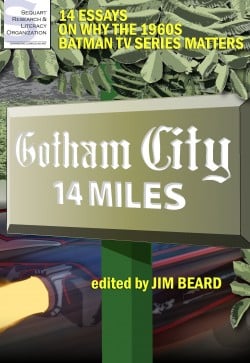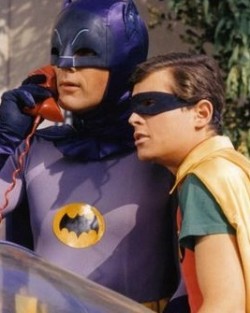Latest Gear Live Videos
Tuesday May 4, 2010 12:26 am
Q&A: Jim Beard, Batman & Gotham City 14 Miles
 If you’re a fan of the 1960s Batman TV show starring Adam West and Burt Ward, then you already know what that phrase means. It’s the sign you see denoting the distance from the Batcave to Gotham City. Wayne Manor was way out in the 1960s suburbs! Gotham City 14 Miles is much more than that, however. It’s also the title of a new book edited by Jim Beard whose full title is Gotham City 14 Miles: 14 Essays On Why The 1960s Batman TV Series Matters. Essayists include Beard, comics historians Peter Sanderson and Robert Greenberger, and a host of people whose names are being revealed one at a time.
If you’re a fan of the 1960s Batman TV show starring Adam West and Burt Ward, then you already know what that phrase means. It’s the sign you see denoting the distance from the Batcave to Gotham City. Wayne Manor was way out in the 1960s suburbs! Gotham City 14 Miles is much more than that, however. It’s also the title of a new book edited by Jim Beard whose full title is Gotham City 14 Miles: 14 Essays On Why The 1960s Batman TV Series Matters. Essayists include Beard, comics historians Peter Sanderson and Robert Greenberger, and a host of people whose names are being revealed one at a time.
The book will be published by the Sequart Research & Literacy Organization a “non-profit devoted solely to the study and promotion of the artistic and literary medium alternately known as comics, comic strips, comic books, graphic novels, manga, sequential art, and sequart.”
Beard says Gotham City 14 Miles is the first book on the old Batman TV series in over 10 years, and I say it’s about time. The book will examine the 1966-68 TV series and “quantify its worth and weight in current pop culture. It also intends to shoot down many of the cliches, falsehoods and outright misinformation about the show and illuminate its strengths and, yes, its weaknesses.”
 Editor Beard has set up a Facebook page for the book so fans can follow along as he teases out the contents and updates the book’s progress. He has also established a dedicated email address GC14M (at) yahoo.com to handle business for the book (so if you want to contact Jim, interview him for your podcast or get him to show up at your con or store, he’s there for you.)
Editor Beard has set up a Facebook page for the book so fans can follow along as he teases out the contents and updates the book’s progress. He has also established a dedicated email address GC14M (at) yahoo.com to handle business for the book (so if you want to contact Jim, interview him for your podcast or get him to show up at your con or store, he’s there for you.)
Now, let’s talk Batman...
Tom Mason: What is it about the Batman TV show that so many people now hold dear?
Jim Beard: If you grew up with it, chances are you have a special place for it in your heart. I can’t speak for anybody but myself but it was my first real exposure to the character and to super-heroes in general, so it looms pretty large in my psyche. Above and beyond that, I think the show represents a simpler, less barnacled view of heroes and I suspect a lot of people my age still pine for that. It was a short blast on a trumpet that’s still reverberating today.
Tom: How did the book come about?
Jim: Well, it came about in a fairly straightforward manner, thank goodness! I’ve long felt there just isn’t enough coverage of the show out there and after meeting Julian and Mike from Sequart at the ’09 NYCC I pitched the idea to them: a book of essays that would take a new, fresh look at the show. They accepted the pitch after a really great discussion on direction and tone and I then started to collect contributors.
Tom: How did you select the contributors?
Jim: Went out and approached each one individually – some of them are friends and others I knew by reputation – but each one was chosen because they had something to bring to each topic. I’m blessed with one of the best – and most eclectic – group of essayists ever assembled!
Tom: Except for Bob Greenberger and Peter Sanderson, I haven’t seen a full list of all the contributors yet. Who’s who?
Jim: The GC14M Facebook page is releasing each “mile marker,” i.e., the chapter information, once every Wednesday. I urge everyone to check in there and count the miles with us!
Tom: How very Jokerish of you! What’s the book’s target audience?
Jim: I like to say that the book is for people who love the show – and for people who hate it. It’s not a lovefest, nor is it a skewering, but there are elements of both present. Sequart was adamant about it being a critical and analytical observance of the show, but also readable and accessible by anyone. I think – hope! – it will appeal to comics fans, TV fans and pop culture fans in general.
Tom: Have you been in touch with any of the surviving cast and crew about the book?
Jim: No. May sound strange but being as the book is a critical examination of the show and not an outright celebration of it, I’m not so sure how interested the surviving cast would find it. It’s not a bashfest but it’s also not a lovefest. That said, I’d be over the moon if any of them did find the book and like something in it or feel we had succeeded in zeroing in on something important.
Tom: In the context of the show, isn’t it true that Robin is the smarter, more aware member of the team? He always solves the Riddler’s riddles, figures out where the Joker will strike next and even though he’s a “kid” he knows about every museum exhibit, grand opening, cocktail party, high society event, and parade in the city.
Jim: No, Robin is definitely the junior partner here, in most respects. He flubs and blunders as much as anyone. Batman’s not perfect, and I talk about his fallibility in my own essay, but he’s still the teacher, the wise man, the moving force behind the Duo.
Tom: So what does that make Robin?
Jim: Rob is…let’s say, more clever than his mentor, in some ways. A child’s cleverness. The riddles come easier to him because he sees them as a game, something for which the straight-backed Batman has difficulty loosening up. He’d get them eventually - or already has got them - but impetuous Robin blurts the answers out, hoping to impress his teacher/parent. There’s an essay about this in the book.
Tom: Where do you think the show falls in the pop culture pantheon of the era?
Jim: Of the era? It was a blockbuster in its time. Then, it became one of the most loathed shows in memory. The bigger they are the harder they fall… Today, and I believe the book shows this, it stands as an achievement of casting, writing, design, music and production; the sort of legacy that few TV series then and now can lay claim to. Love it or hate it, the show is unique. That’s what the book is all about.
Tom: What’s the biggest misconception people might have about the TV show?
Jim: Oh, geez, where to start! Probably that it’s an out-and-out comedy with no other redeeming value. I believe this misconception stems from the fact that most of the people who have that view have either not seen an episode in a long, long time, or have never seen one at all. It’s been murdered by word-of-mouth and sound-bites. It needs to be put out on DVD so that everyone can watch the damn thing and decide for themselves if it was a travesty – or a wonder.
Tom: I don’t think the show is a comedy in the traditional sense, but there are moments where I find it genuinely funny, from Adam West’s delivery, to the sillier stuff like putting signs on everything, and weirdly funny stuff like seeing Alfred casually sitting in the Batmobile. What parts do you find funny?
Jim: Lots, but for me the funniest parts are the more subtle things, like certain expressions on certain actors’ faces - not the overt “jokey” things. The show is comedic but not a comedy. I hope that makes sense.
Tom: It does to me. Is there a part that you find serious? For me it’s the idea that if this was a comedy, how do you explain that the Dynamic Duo was stuck in a death trap at the end of every episode. Friends never hung Joey over a pot of boiling oil.
Jim: Again, lots of it. The Dynamic Duo were deadly serious in their mission - which gave the show a serious core. There was also social commentary, political satire and other more-or-less serious things. Plus, Batman’s lessons are delivered honestly and sincerely.
Tom: Do you have a favorite episode?
Jim: When I was a kid it would have been any episode with Batgirl in it! Today, I’d have to say that the first three or so stories are so very satisfying to view. The balance of zaniness and seriousness is really at its finest in those early episodes and I think they’d be a revelation to a lot of folks if they could only watch them today on high-quality DVDs. The colors and sounds alone would knock people’s socks off, I’m sure.
Tom: So, favorite Catwoman: Eartha Kitt, Julie Newmar or Lee Meriwether?
Jim: Lee, the dark horse candidate.
Tom: Me, too. I also think she’s the better actress. What do you think the long-term impact of the show was on comics, pop culture and the audience?
Jim: Read the book! Seriously, its impact is so widespread that it’d be hard to quantify here in this interview. It’s not just comic writers and artists but also filmmakers and inventors and scientists and musicians and…
Tom: After this, what’s the next project?
Jim: I have Ghostbusters Summer Special: Con-Volution! out this June from IDW with writer Keith Dallas, and I’m also working on a pulp prose story for Airship 27 and TwoMorrows’ American Comic Book Chronicles: The 1980s. After that, hopefully another book of essays with Sequart! Stay tuned!
Gotham City 14 Miles will be published by Sequart in October 2010.Bat-fans. Keep checking the Facebook page and watch the internets for new developments in the world of Gotham City: 14 Miles.
[Artwork: cover to Gotham City 14 Miles, courtesy of Jim Beard (top); publicity still from the Batman TV show (bottom)]
- Related Tags:
- adam west, batman, bob greenberger, burt ward, catwoman, dark horse, dc, eartha kit, gotham city 14 miles, interview, interviews, jim beard, joker, julie newmar, lee meriwether, peter sanderson, robin, sidefeatured, television
Advertisement
Advertisement
Advertisement
© Gear Live Media, LLC. 2007 – User-posted content, unless source is quoted, is licensed under a Creative Commons Public Domain License. Gear Live graphics, logos, designs, page headers, button icons, videos, articles, blogs, forums, scripts and other service names are the trademarks of Gear Live Inc.












Comments: